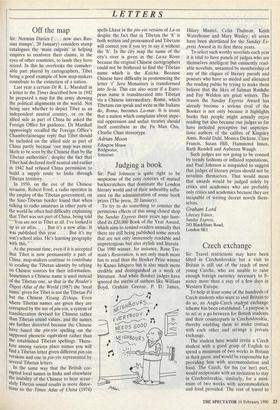LETTERS Off the map
Sir: Norman Davies (.. . . now uses Rus- sian stamps', 20 January) considers stamp catalogues the 'main culprits' in helping empires to reinforce their claims, in the eyes of other countries, to lands they have seized. In this he overlooks the consider- able part played by cartographers, Tibet being a good example of how map-makers contribute to the extinction of a nation.
Last year a certain Dr R. L. Marshall in a letter to the Times described how in 1942 he prepared a map for the army showing the political alignments in the world. Not being sure whether to depict Tibet as an independent neutral country, or on the allied side as part of China he asked the Foreign Office for guidance. Dr. Marshall approvingly recalled the Foreign Office's Chamberlainesque reply that Tibet should be included on the allied side as part of China partly because 'our map was more likely to be seen by the Chinese than by the Tibetan authorities', despite the fact that Tibet had declared itself neutral and earlier in 1942 had refused China permission to build a supply route to India through Tibetan territory.
In 1950, on the eve of the Chinese invasion, Robert Ford, a radio operator in the employ of the Tibetan government, on the Sino-Tibetan border found that when talking to radio amateurs in other parts of the world he often had difficulty explaining that Tibet was not part of China, being told "You are not in Tibet at all. I've looked it up in an atlas. . . But it's a new atlas. It was published this year . . . But it's my son's school atlas. He's learning geography with this."
At the present time, even if it is accepted that Tibet is now permanently a part of China, map-makers continue to contribute to eroding the Tibetan identity by relying on Chinese sources for their information. Sometimes a Chinese name is used instead of the Tibetan one, so that in the Reader's Digest Atlas of the World (1987) the 'local name' given for Tibet is not the Tibetan PO but the Chinese Xizang Zizhiqu. Even where Tibetan names are given they are corrupted by the use of pin-yin, a system of transliteration devised for Chinese rather than Tibetan sound values, and the names are further distorted because the Chinese have based the pin-yin spelling on the supposed phonetic equivalent rather than the established Tibetan spellings. There- fore among various place names you will find a Tibetan letter given different pin-yin versions and one in pin-yin represented by several Tibetan letters.
In the same way that the British cor- rupted local names in India and elsewhere the inability of the Chinese to hear accur- ately Tibetan sound results in more distor- tions so the Times Atlas of China (1974)
spells Lhasa in the pin-yin version of La-sa despite the fact that in Tibetan the 'h' is both written and pronounced and Tibetans will correct you if you try to say it without the 'W. In the city map the name of the city's river is given as the La-sa River because the original Chinese cartographers could not be bothered to find the Tibetan name which is the Kyichu. Because Chinese have difficulty in pronouncing the letter 'r' Sera Monastery is transformed into Se-la. This can also occur if a Euro- pean name is transliterated into Tibetan via a Chinese intermediary. Rome, which Tibetans can speak and write as the Italians do, Roma, becomes Lo-mar. It is ironic that a nation which complains about impe- rial oppression and unfair treaties should itself contribute to the Fu Man Chu, Charlie Chan stereotype.
Adrian Moon
Edington House Bridgwater, Somerset


















































 Previous page
Previous page